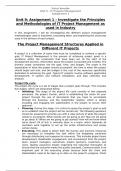Essay
Unit 9 IT Project Management Assignment 1 (Learning Aim A) Distinction
- Course
- Institution
UNIT 9 IT PROJECT MANAGEMENT, COVERS ALL CRITERIA DISTINCTION LEVEL ASSIGNMENT Learning aim A: Investigate the principles and methodologies of IT project management as used in industry A.P1 Explain, using appropriate definitions, the characteristics of different methodologies applied in...
[Show more]




